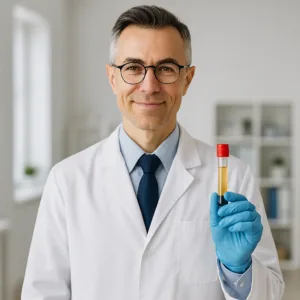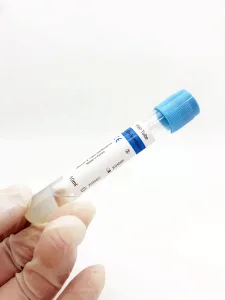PRP injection is one of the most widely used regenerative treatments worldwide. By using the patient’s own blood to concentrate platelets and growth factors, PRP injections help stimulate natural healing, improve skin rejuvenation, restore hair growth, and even support orthopedic recovery. As a result, clinics that master the PRP injection procedure can offer patients a safe, effective, and in‑demand therapy.
Moreover, understanding the science, the step‑by‑step procedure, and the tools required for PRP injections is critical to delivering consistent results and high patient satisfaction. This guide provides a complete overview of PRP injection therapy, from preparation to clinical applications, and it includes insights into choosing PRP tubes that deliver reliable platelet yield.
💡 Clinics trust IPPOCARE’s CE-certified Classic PRP Tubes for reliable platelet recovery and patient safety.
What Is a PRP Injection?
PRP (Platelet-Rich Plasma) injection is a minimally invasive medical procedure that uses concentrated platelets derived from the patient’s own blood. These platelets release growth factors that stimulate healing, collagen production, and tissue regeneration.
During the procedure:
- The clinician draws blood from the patient using sterile collection materials.
- Next, the clinician processes the blood in PRP tubes containing anticoagulant and separating gel, then centrifuges it to isolate platelet rich plasma.
- Finally, the clinician injects the concentrated plasma into the target area, whether skin, scalp, joints, or surgical wounds.
Because PRP uses the patient’s own biological material, it is considered safe, biocompatible, and natural, with minimal risk of adverse reactions.

How PRP Injections Work: The Science Behind Platelets
Platelets are not just clotting agents; they are biological powerhouses filled with alpha granules that store essential growth factors responsible for healing and regeneration. These include:
- Platelet-Derived Growth Factor (PDGF): Stimulates cell growth and division.
- Transforming Growth Factor Beta (TGF-β): Regulates inflammation and accelerates tissue repair.
- Vascular Endothelial Growth Factor (VEGF): Encourages the formation of new blood vessels (angiogenesis).
- Epidermal Growth Factor (EGF): Promotes skin cell regeneration and wound healing.
- Insulin-Like Growth Factor (IGF): Plays a key role in tissue remodeling and recovery.
When a PRP injection is administered, these growth factors are released in high concentration directly at the treatment site. This release triggers a regenerative cascade:
- Fibroblasts are activated, leading to collagen and elastin production for stronger, firmer skin.
- Angiogenesis improves circulation by forming new capillaries and blood vessels.
- Stem cell recruitment accelerates the repair of damaged or aging tissue.
When PRP is injected, these growth factors activate fibroblasts, boost collagen/elastin production, improve circulation, and trigger stem cell activity. This explains why PRP injections are used in aesthetics, hair restoration, orthopedics, and wound repair.
Clinical Applications of PRP Injections
1. Dermatology & Aesthetics
- Facial PRP (“Vampire Facial”): restores glow, elasticity, and firmness
- Under-Eye PRP: reduces dark circles and fine lines
- Scar Treatment: improves acne scars and surgical marks
- Combination Treatments: Often paired with microneedling or hyaluronic acid fillers for amplified results
➡️ Recommended Tube: PRP Tube with HA – ideal for facial PRP and skin hydration.

2. Hair Restoration
- PRP is injected into the scalp to stimulate dormant follicles and improve hair density.
- Works best for androgenetic alopecia and thinning hair in early to moderate stages.
➡️ Recommended Tube: PRP Tube with Biotin – enriched with Vitamin B7 to nourish follicles and enhance regrowth.

3. Orthopedics & Sports Medicine
- Used for tendon injuries, arthritis, and post-surgical recovery
- Reduces pain, promotes faster healing
4. Dentistry & Gynecology
- Supports healing after dental surgery
- Used in gynecology for tissue regeneration and recovery
Step-by-Step PRP Injection Procedure
1. Patient Consultation
- First, assess medical history and contraindications such as platelet disorders or active infections.
- Then, explain realistic outcomes and obtain informed consent.
2. Blood Collection
- Draw ten to twenty milliliters of blood using sterile PRP tubes.
- Use butterfly needles and transfer syringes to maintain sterility.
➡️ Classic PRP Tube – ACD + separating gel for pure platelet yield.
3. Centrifugation
- Place PRP tubes in a medical centrifuge.
- Spin according to tube specifications (commonly 3000 rpm for 8–10 minutes).
- Separation gel ensures clear isolation of platelet-rich plasma.
4. PRP Extraction
- Use sterile syringes to extract the upper plasma layer.
- Avoid red blood cell contamination.
5. Injection Technique
- Local anesthetic may be applied.
- Inject PRP into target areas using fine needles (e.g., mesotherapy needles for skin, longer needles for joints).
- Use micro-injections or fanning technique depending on treatment site.
Benefits of PRP Injections
1. Safe and Autologous Treatment
One of the greatest advantages of PRP injections is that they are autologous, meaning the treatment uses the patient’s own blood. Unlike dermal fillers or synthetic injectables, PRP carries virtually no risk of allergic reaction or rejection. For clinics, this safety profile not only reduces liability but also helps build patient trust, making PRP an attractive addition to any treatment portfolio.
2. Minimally Invasive with Quick Recovery
PRP injections are performed as an outpatient procedure that takes less than an hour, including blood collection, centrifugation, and injection. Patients experience little to no downtime, with most returning to normal activities the same day. This makes PRP a popular option for clients who prefer nonsurgical treatments with minimal disruption to their routine, while clinics benefit from faster turnover and higher appointment volume.
3. Wide Range of Applications
PRP therapy is exceptionally versatile, making it suitable for multiple specialties:
- Dermatology & Aesthetics: facial rejuvenation, scar improvement, under-eye dark circles.
- Hair Restoration: stimulating dormant follicles and strengthening thinning hair.
- Orthopedics & Sports Medicine: speeding up recovery from tendon injuries and arthritis.
- Dentistry & Gynecology: enhancing surgical healing and tissue repair.
This multi-disciplinary use allows clinics to maximize ROI on a single technology by offering PRP across different services.
4. Meeting High Patient Demand
Patients today are increasingly seeking natural, regenerative therapies that align with holistic wellness trends. PRP injections are often marketed as “using your body’s own healing power,” which strongly appeals to health-conscious clients. By offering PRP, clinics can position themselves as modern, science-driven, and patient-focused, ensuring they meet rising demand in both aesthetics and functional medicine.
5. Expanding Clinic Revenue Streams
PRP therapy represents not just a clinical advancement, but also a business opportunity. Because PRP can be packaged as a series of treatments—commonly three sessions with maintenance every 6–12 months—clinics benefit from repeat bookings and long-term patient relationships. Moreover, pairing PRP with other treatments such as microneedling, hyaluronic acid fillers, or hair restoration programs allows clinics to create high-value treatment packages that boost profitability while improving patient outcomes.
Choosing the Right PRP Tubes for Reliable Results
Your results depend on the tubes you use. Here’s a quick comparison:
Key features of professional-grade tubes:
- Anticoagulant (ACD) to prevent clotting.
- Separating Gel for clear plasma isolation.
- Sterile, vacuum-sealed design to reduce contamination risk.
- Certified quality (CE, ISO) for compliance and safety.
Types of PRP Tubes Available:
- Classic PRP Tube – Standard PRP preparation, high platelet yield.
- PRP Tube with HA – With hyaluronic acid for skin rejuvenation.
- PRP Tube with Biotin – With biotin for hair restoration.
➡️ View our full selection: Shop PRP Tubes
| Tube Type | Best For | Additives | Shop |
|---|---|---|---|
| Classic PRP Tube (10mL/12mL) | General use – facial, hair, orthopedic | ACD + separating gel | Classic Tube |
| PRP Tube with HA | Facial rejuvenation + microneedling | ACD + HA (16mg/mL) | PRP Tube with HA |
| PRP Tube with Biotin | Hair restoration & follicle health | ACD + Biotin (0.5mL) | PRP Tube with Biotin |
➡️ For bulk orders, explore our Wholesale PRP Tubes or contact us directly.
Potential Side Effects & Safety Considerations
PRP injections are generally safe, but clinics should inform patients about possible minor effects:
- Redness, swelling, or bruising at injection site.
- Temporary discomfort or pressure.
- Rare: infection if sterility is compromised.
Always use CE/ISO-certified, triple-sterilized PRP tubes to ensure safety and consistency.
PRP Injection vs. Other Treatments
| Treatment | Source & Material | Main Benefits | Duration of Results | Downtime | Ideal Use Cases |
|---|---|---|---|---|---|
| PRP Injections | Patient’s own blood (autologous, natural) | Stimulates collagen, repairs tissue, promotes hair growth, natural skin rejuvenation | 6–12 months (with maintenance) | Minimal (same-day recovery) | Skin rejuvenation, hair restoration, joint healing, post-surgical recovery |
| Dermal Fillers (HA) | Synthetic hyaluronic acid gels | Immediate volume restoration, wrinkle reduction, facial contouring | 6–18 months | Minimal (possible swelling/bruising) | Wrinkles, lips, facial volume loss |
| Botox (Botulinum Toxin) | Purified neurotoxin | Smooths fine lines and wrinkles by relaxing muscles | 3–6 months | Minimal (1–2 days) | Forehead lines, crow’s feet, frown lines |
| Microneedling | Micro-injuries with fine needles | Stimulates collagen production, improves skin texture and scars | Long-term (after multiple sessions) | 1–2 days of redness | Acne scars, skin texture, pore size |
| Laser Resurfacing | Light/heat-based technology | Improves pigmentation, tightens skin, stimulates collagen | Long-lasting (1–2 years) | 5–10 days recovery | Pigmentation, sun damage, deeper wrinkles |
Why PRP Stands Out for Clinics
- Natural & autologous: uses the patient’s own blood, unlike synthetic injectables.
- Versatile: applicable in aesthetics, hair restoration, orthopedics, dentistry, and gynecology.
- Low downtime: patients can return to normal life the same day.
- High ROI: repeat sessions and combination packages make it profitable for clinics.
FAQs About PRP Injections
Which PRP tube is best for hair loss?
PRP Tube with Biotin – specifically designed for hair follicle support.
Which tube is best for facial PRP/facial treatments?
Clinics often prefer PRP tube with HA for added hydration and glow.
How long does a PRP injection take?
Usually 30–45 minutes, including blood collection, centrifugation, and injection.
Do you ship internationally?
Yes, IPPOCARE PRP Tubes are shipped worldwide.
How many sessions are needed?
Most patients need 3 sessions spaced 4–6 weeks apart, with maintenance every 6–12 months.
When will patients see results?
For hair: noticeable improvement after 2–3 months. For skin: within 4–6 weeks.
Are PRP injections painful?
Discomfort is mild and can be reduced with topical anesthetic.
PRP injections are a proven, natural therapy that deliver results across multiple specialties—aesthetics, hair restoration, orthopedics, dentistry, and gynecology.
For consistent results, clinics must prioritize high-quality PRP tubes with reliable separation and sterilization. Whether using Classic PRP Tubes for general treatments, PRP Tubes with HA for facial rejuvenation, or PRP Tubes with Biotin for hair restoration, the right tools make all the difference.
➡️ Explore our full range of PRP Tubes to support your clinic with CE-certified, sterile solutions designed for professional use.
✅ Shop Classic PRP Tubes – best for general treatments
✅ Buy PRP Tube with Biotin – optimized for hair restoration
✅ Buy PRP Tube with HA – perfect for skin & microneedling
✅ Request Bulk Pricing – wholesale options for clinics & distributors


